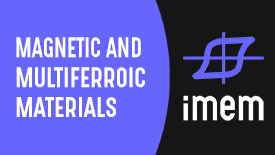Rare Earth - free Permanent Magnets
The main aim is to develop novel hard magnetic materials that do not contain Rare Earth elements and to investigate their properties and reversal process mechanism. Nowadays, due to the actual socio-economic situation, Rare Earths are the most important Critical Raw Materials. The research of alternative materials that can substitute RE hard magnets is a hot-topic in material science.
The research of MAGFUN team is focused in the free RE hard ferrites: M– type hexaferrites and Cobalt ferrites. The activity is performed considering different designs of materials: (a) nanoferrites in the single domain regime, (b) hybrid systems with the exchange bias or spring magnet coupling mechanisms, (c) doped ferrites with enhanced properties and (d) improved materials by mixtures and orientation. Moreover, the research on the properties, like magnetization, Curie temperature and anisotropy field, and on the reversal process mechanisms are performed.
Highlights
-
Optimization of the particle size of Cobalt ferrite nanoparticles for magnets
We have investigated the structural and magnetic properties of a series of Cobalt ferrite nanoparticles with sizes between 8 nm to 80 nm (Ref 4). Cobalt ferrite constitutes the Fe oxide with the largest magnetic anisotropy between the spinel oxides. While the bulk ferrite is characterized by a cubic magnetocrystalline anisotropy, in nano we have demonstrated that the effective anisotropy is a combination of bulk, shape and surface anisotropies. Investigating the temperature dependence of the magnetization and of the hysteresis loops we have shown that particles of cubic-like shape and 20 nm of average size exhibit both the largest anisotropy (1.2 MJm-3) as the largest coercive field (1.6 T) at 5 K , temperature at which no thermal activation process is on. At room temperature, the particles with 40 nm average size are blocked exhibiting a coercive field of 0.3 T, and a (BH)max of 18 kJ/m−3, values that are competitive to the value of the standard commercial hexaferrites.
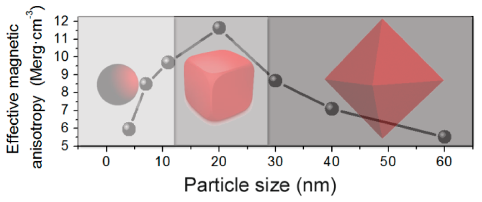
Variation of the effective anisotropy as function of the Cobalt ferrite particle size estimated at zero temperature and the evolution of the morphology of the particles. Reprinted with permission from A. López-Ortega et al. Chem. Mater. 2015, 27, 4048−4056. Copyright 2015 American Chemical Society, 10.1021/acs.chemmater.5b01034
-
Coupled core-shell nanoparticles with high magnetic anisotropy
The morphological, structural and magnetic properties of novel hybrid hard nanoparticles obtained from the oxidation or reduction of seed nanoparticles (Ref 1,2,3) were investigated. The oxidation of antiferromagnetic FeCo monoxide nanoparticles gives rise to magnetic core@shell nanoparticles in which the ferrimagnetic shell is composed by Cobalt ferrite that grows epitaxially on the mono-oxide core. All these structures exhibit the typical fingerprint of the exchange-bias effect: a shift in the hysteresis loop under field-cooling conditions. Also, it appears an enhancement of the coercive field and an increase of the (BH)max of 7 times in comparison the values measured under zero-field conditions. Nanostructures with different total sizes and core/shell ratio were investigated, being proposed different contributes to the exchange bias effect. These studies show the possibility to exploit the exchange bias effect as novel strategy to develop RE-free magnets.
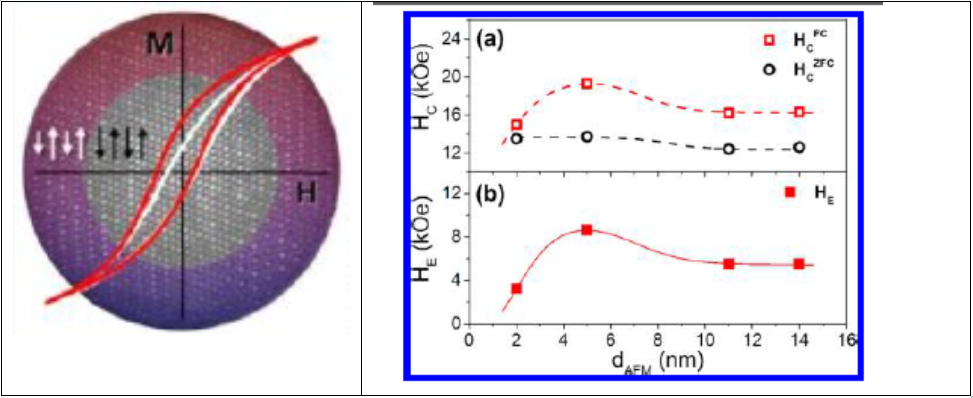 Model of Core@shell nanoparticle with antiferromagnetic coupling at the interface and the exchange bias behavior. This is evidenced by the shift of the hysteresis under field-cooling conditions. (b) variation of the coercive field under zero-field and field cooling conditions and of the exchange field for CS nanoparticles with shell of Cobalt ferrite of 2 nm and variable core made of CoFe monoxide. Reprinted with permission from E. Lottini et al. Chem. Mater. 2017, 29, 1279-1289. Copyright 2016 American Chemical Society. 10.1021/acs.chemmater.6b00623
Model of Core@shell nanoparticle with antiferromagnetic coupling at the interface and the exchange bias behavior. This is evidenced by the shift of the hysteresis under field-cooling conditions. (b) variation of the coercive field under zero-field and field cooling conditions and of the exchange field for CS nanoparticles with shell of Cobalt ferrite of 2 nm and variable core made of CoFe monoxide. Reprinted with permission from E. Lottini et al. Chem. Mater. 2017, 29, 1279-1289. Copyright 2016 American Chemical Society. 10.1021/acs.chemmater.6b00623
Main publications
- "Topotaxial phase transformation in cobalt doped iron oxide core/shell hard magnetic nanoparticles" - A. López-Ortega, E. Lottini, G. Bertoni, C. de Julián Fernández, C. Sangregorio - Chemistry of Materials 29 (2017) 1279–1289 - DOI: 10.1021/acs.chemmater.6b04768
- "Strongly Exchange Coupled Core|Shell Nanoparticles with High Magnetic Anisotropy: A Novel Strategy towards Rare Earth-Free Permanent Magnets" - E. Lottini, Al. López-Ortega, G. Bertoni, S. Turner, M. Meledina, G. Van Tendeloo, C. de Julián Fernández, C. Sangregorio - Chemistry of Materials 28 (2016) 4214–4222 - DOI: 10.1021/acs.chemmater.6b00623
- ”Energy product enhancement in imperfectly exchange-coupled nanocomposite magnets" - A. Quesada, C. Granados, A. López-Ortega, S. Erokhin, E.Lottini, J. Pedrosa, A. Bollero, A. M. Aragón, F. Rubio-Marcos, M. Stingaciu, G. Bertoni, C. de Julián Fernández, C. Sangregorio, J. F. Fernández, D. Berkov, M. Christensen - Advanced Electronic Materials 2 (2016) 1500365 - DOI: 10.1002/aelm.201500365
- "Exploring the magnetic properties of cobalt-ferrite nanoparticles for the development of rare-earth-free permanent magnet" - A. López-Ortega, C. Lottini,C. de Julián Fernández,C. Sangregorio - Chemistry of Materials 27 (2015) 4048–4056 - DOI: 10.1021/acs.chemmater.5b01034+ESI
High Tc Superconductors (HTS)
IMEM has a long and prestigious experience on the synthesis and characterization of superconducting materials (SPC), mainly in the preparation (bulk and single crystal) of high transition temperature cuprates (HTS) and in the deposition of two-dimensional tapes on flexible substrates (YBCO-based Coated Conductors).
Thanks to the availability of powerful devices capable of operating in conditions of very high pressure and temperature (HP/HT), in the last years the study has focused on the HP/HT synthesis of HTS with the aim of: i) obtaining new metastable compounds. ii) Carry out chemical substitutions on known materials not allowed at ambient conditions. iii) Apply high oxygen pressures to study and review in particular the “overdoped” HTS regime.
The ultimate goal is to obtain phases with higher superconductive transition temperature (Tc) and / or to correlate Tc with structural distortions, stabilized by HP/HT.
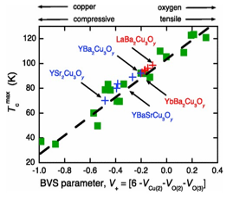
From: doi.org/10.1103/PhysRevLett.111.237001
Highlight
Specific chemical substitutions (i.e. Ba/Sr in YBCO > YSCO) and the preparation of HTS in high-oxygen pressure, only viable by HP/HT synthesis HP/HT, allow to define a second-phase diagram, needed to describe “overdoped” cuprates regime. The transition temperatures of HPO compounds continue to increase past the values of O stoichiometry and Cu charge, where the conventional SPC vanishes. The high degree of similarity between the HPO and normal structures, including a Cu2-apical O two-site distribution, suggests that the elevated Tc of HPO (fpr example YSCO–Mo) may originate in a combination of nanoscale heterogeneity and dynamical properties.
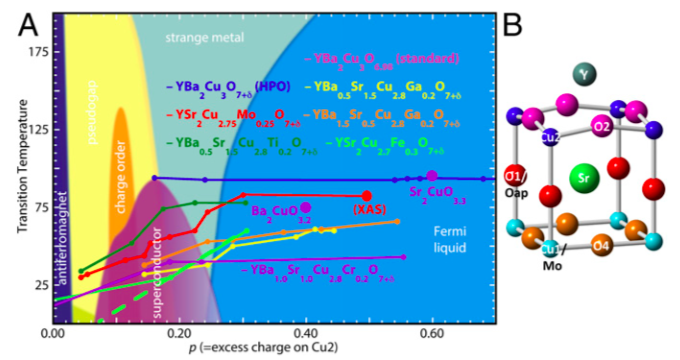
From: doi.org/10.1073/pnas.1918704117








